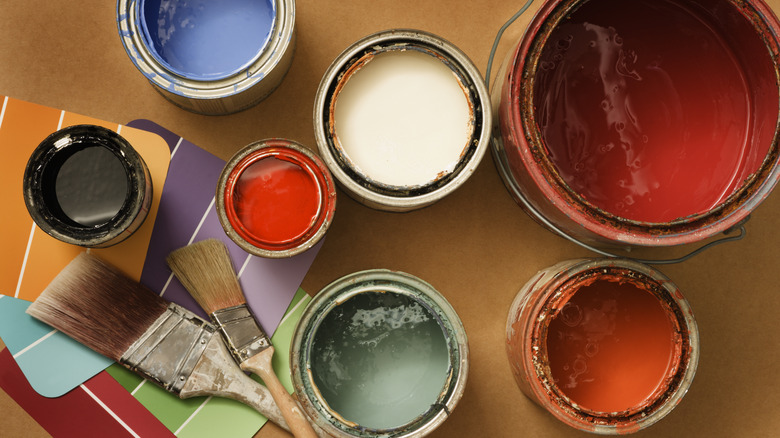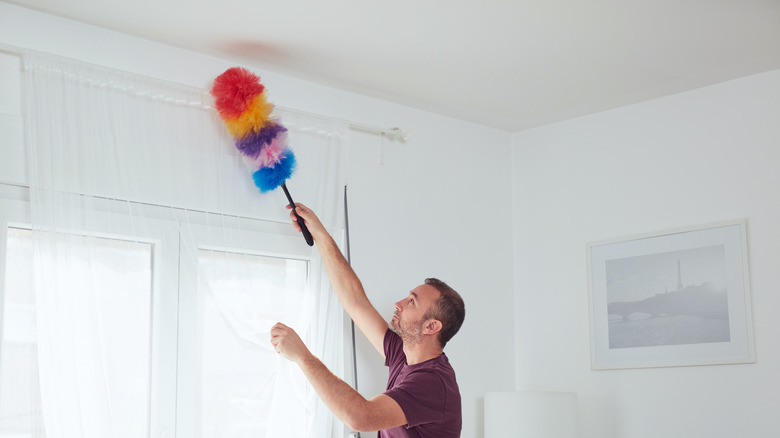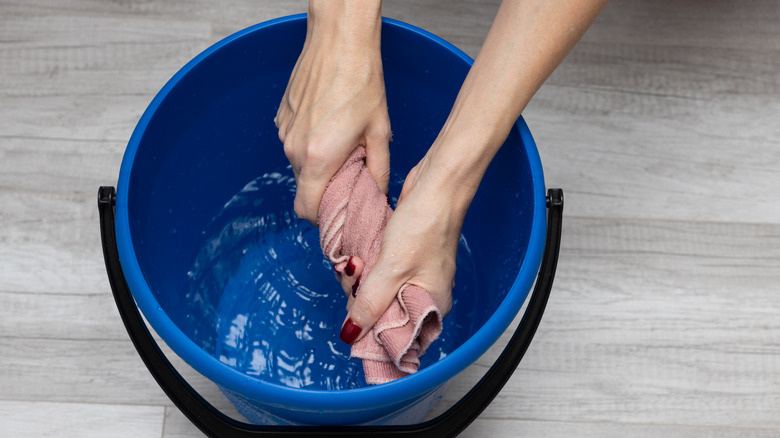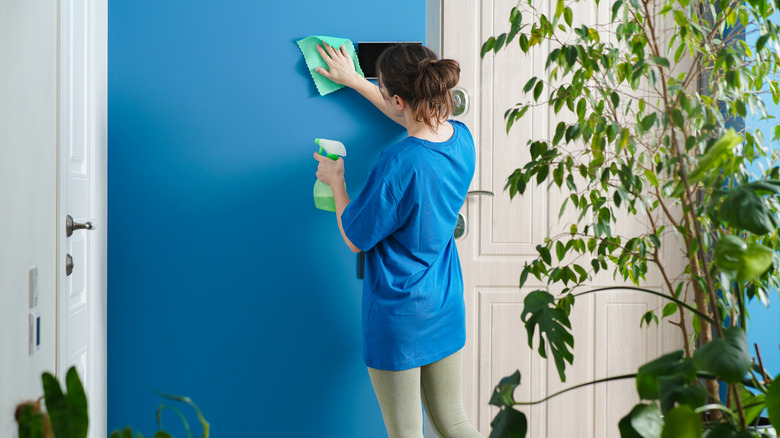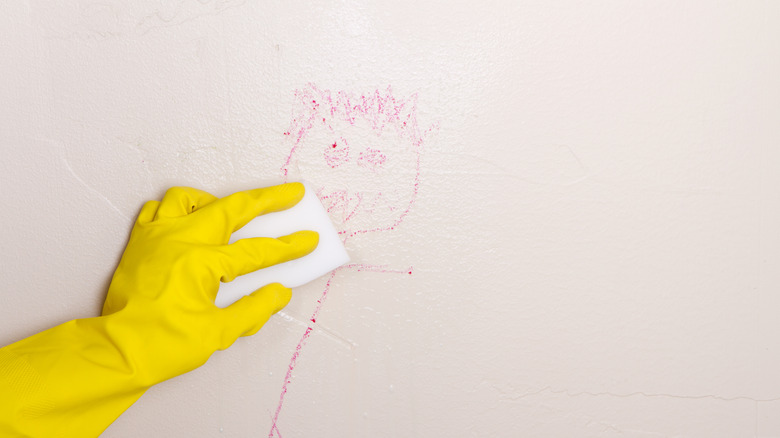5 Mistakes Everyone Makes When Cleaning Painted Walls
After investing time, money, and effort into finding the perfect paint color for your walls, the last thing you want is to inadvertently cause damage to the paint while you're just trying to keep it clean. Believe it or not, cleaning painted walls isn't as simple as going to town on them with a wet towel and your favorite all-purpose cleaner. Different types of paint are sensitive to different cleaning products, and using the correct product on your painted walls is important to avoid ruining the paint job. Plus, some cleaning strategies—gently wiping vs. aggressively scrubbing—are far better than others when it comes to cleaning painted walls. However, if you avoid a few common mistakes when cleaning your walls, you should be able to keep that paint looking spiffy without causing any damage.
No matter what strategy you use to clean your interior walls, you should spot-test them first. Whether you clean a minuscule spot in the bottom corner or a portion of the painted wall hidden behind your couch, spot testing can help prevent disaster by revealing if your cleaning method will damage a small portion of the wall rather than the entire surface.
Not keeping paint type and finish in mind
One common mistake made when washing painted walls is not cleaning according to the finish of the walls. The ease of cleaning painted walls greatly depends on what type of paint finish they have. For example, paints with a glossy finish are easy to clean and won't need to be scrubbed very hard to get them sparkling. Those with a satin finish are a little more challenging, and matte and flat paints will take the most elbow grease to clean. With that in mind, you shouldn't scrub any type of painted wall too hard. It's also essential to avoid using too much water to clean any painted walls with a flat finish, as this type of finish is very susceptible to water damage. A dry sponge and gentle detergent are your best bet for cleaning these walls.
Paint composition is a factor that's just as important to keep in mind when cleaning your walls, as certain types of paint react differently to certain cleaners. For example, if you need to clean a latex-based paint, you only need to use warm water and a gentle soap. Be sure not to use any abrasive cleaners on walls painted with latex-based paints. However, if you're cleaning walls painted in an oil-based paint like acrylic, you can start with warm water and soap, and if that doesn't do the trick, you can use isopropyl alcohol to remove any marks or stains and easily clean dirty walls.
Not starting with a simple dusting
Another common mistake people make when cleaning painted walls is getting a little overzealous and jumping straight to cleaning with products before a simple dusting. It's very important to dust your walls before trying to clean them with any liquid products because if you put water or liquid on a wall covered in dust, that dust will quickly transform into mud, which will be much more difficult to clean. You also risk just smearing the dirt and mud all around the clean parts of the wall, creating an even bigger mess.
Using a duster, dust mop, or microfiber cloth is the best way to dust your walls before washing them. When dusting, you should start at the top and work your way down to avoid spreading the dust to the parts you've already cleaned. Another reason to dust your walls before washing is that dusting will allow you to see the real problem areas on your painted walls, so you'll know what actually needs to be washed vs. what was just looking a little dusty–saving you time.
Getting the walls too wet
While it's true that you don't want to get flat-finished walls wet at all to clean them, remember that you really don't want to get any paint finish overly wet while washing. It's possible for overly saturated walls to be left with streaks and watermarks, which can turn into stains. To avoid using too much water on your walls, you can clean them with a sponge or microfiber towel and wring it out really well each time you dip it into water or a cleaning solution before applying it to the walls.
If you live in a wet, humid climate, it's even more important that you don't oversaturate your walls with water, as this can cause them to grow mold. Not only can mold cause damage and stains to your painted walls, but mold in your home can cause some serious health problems. For this same reason, you should also take care to dry your walls well after washing them — whether by cranking up the AC to dry out the room, putting a fan on them, or rubbing them down with a dry microfiber towel. Drying after cleaning is definitely a good way to avoid unknowingly ruining your walls.
Using overly harsh chemicals
Another way to cause more harm than good when cleaning your walls is to use overly harsh and abrasive cleaning chemicals, like full-strength bleach and ammonia. For the most part, water, along with a mild detergent, should be sufficient for cleaning. However, sometimes, using something with a little more oomph is necessary to remove bad stains and scuff marks from your walls.
For example, bleach can remove water-based stains on the paint caused by water and food. With that said, you should only use it when nothing else has worked, and never apply straight bleach to your walls. You only need a mixture of one part bleach and three parts water. This strategy should be reserved for tough stains and not be used as your primary cleaning method. Additionally, you should completely avoid using any abrasive chemicals on latex paints and instead use more mild cleansers, like soap or vinegar.
Cleaning them with an abrasive material
Just as you shouldn't clean your painted walls with overly harsh cleaning chemicals, you shouldn't use abrasive materials on them. For example, you should avoid using Magic Erasers on your walls, particularly ones with a flat or matte finish, as they may remove more than just stains; they can also remove paint. The same applies to rough brushes or sponges, which can also damage painted walls.
Instead of using abrasive surfaces to clean your walls, use a microfiber cloth or a very soft sponge. This will help protect your painted walls from scratches while still allowing you to clean them properly. No matter what cleaning material you use, be sure not to scrub too hard, which can also damage the paint. Spot testing any sponge or cleaning solution you plan to use in an inconspicuous place, like inside your closet or behind a door, can save you from making many of these mistakes and likely some extra dollars down the line.

